What is in-app messaging?
In-app messaging refers to delivering messages or notifications directly within a mobile or web application while the user is actively using it. These messages are designed to be contextually relevant and timely, appearing at the moment when users may benefit from additional guidance, information, or support.
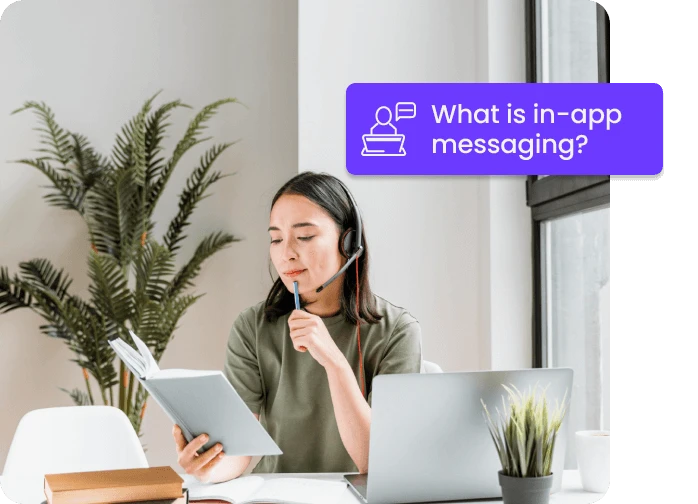
Table of contents
- What is in-app messaging?
- Types of in-app messaging
- What are the benefits of in-app messaging?
- What are the drawbacks of in-app messaging?
- In-app messaging vs. push notifications vs. email tutorials
- Examples of in-app messaging in the workplace
- Big businesses and in-app messaging
- How is an in-app messaging strategy rolled out?
The goal of in-app messaging is to enhance the user experience by providing relevant information, tips, or nudges to users within the application itself.
In-app messages are typically short, concise, and discreet to ensure they don’t disrupt the user experience but enhance it.
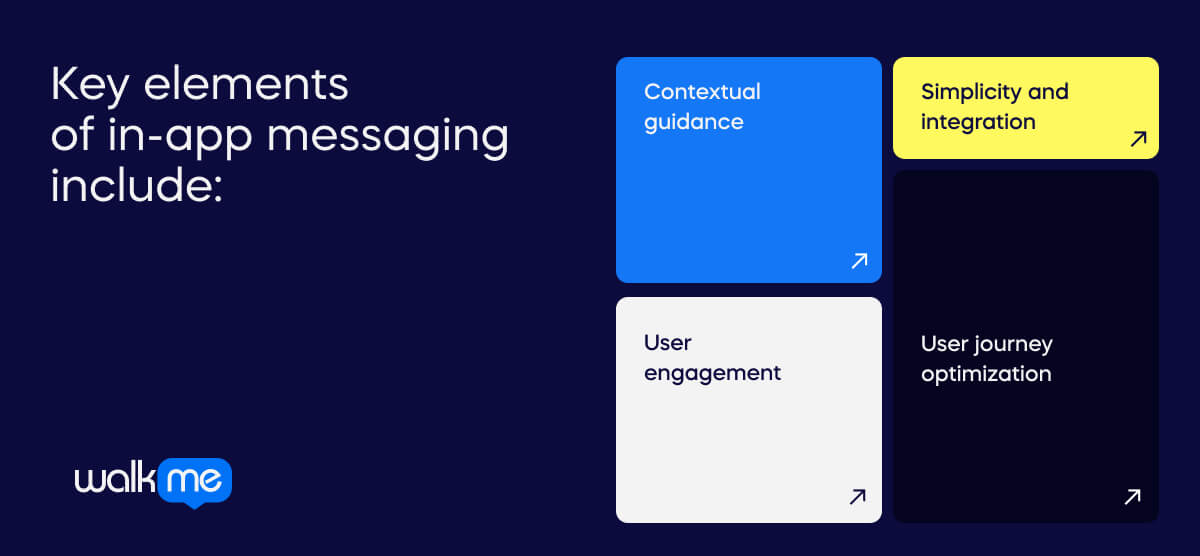
Key elements of in-app messaging include:
Contextual guidance
In-app messaging aims to assist users precisely when they need it.
Developers can strategically deliver messages at opportune moments by analyzing user behavior, actions, or preferences within the application.
This contextual guidance ensures that the information provided is relevant to the user’s current activities, making it more likely to be well-received and beneficial.
User engagement
Engagement is a crucial metric for the success of any application.
In-app messaging is a tool to actively engage users and maintain their interest over time.
By delivering real-time support, tips, or relevant information, applications can keep users involved and interested, ultimately leading to higher retention rates.
Simplicity and integration
In-app messaging offers a straightforward and seamless way to communicate with users directly within the application environment.
This eliminates the need for external communication channels, such as emails or push notifications, streamlining the user experience.
The simplicity of in-app messages contributes to a more intuitive interaction, ensuring that users can easily access and comprehend the provided information.
User journey optimization
Understanding the user journey is essential for delivering a satisfying user experience.
In-app messages contribute to optimizing this journey by offering guidance or suggestions aligned with the user’s current activities.
Whether providing onboarding tips for new users, introducing advanced features, or offering personalized recommendations, these messages aim to enhance the overall user journey and make it more user-friendly.
Types of in-app messaging
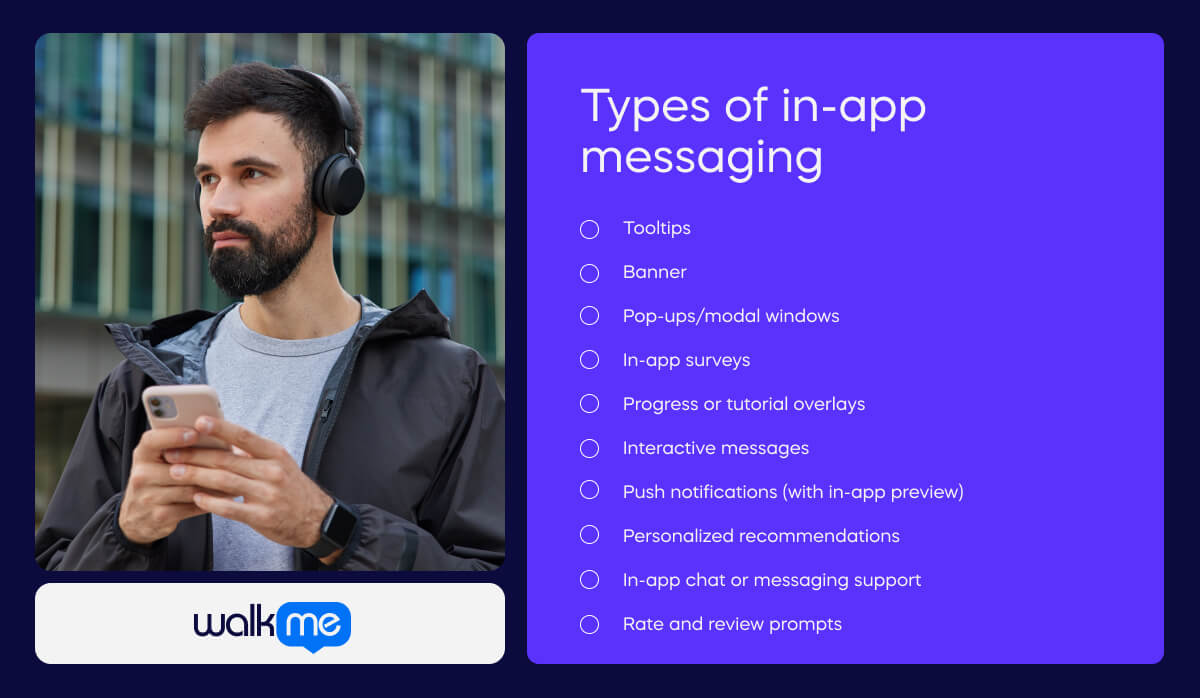
There are several types of in-app messaging, each serving different purposes to enhance the user experience.
Here are some common types:
Tooltips
Tooltips are small, contextual messages that appear when users hover over or click on specific elements within the application.
They are often used for onboarding to briefly explain features or functionalities.
Banner
Banners are non-intrusive messages that appear at the top or bottom of the screen. They are often used for announcements or to highlight important information.
Examples include announcing promotions, informing users about updates, or displaying general notifications.
Pop-ups/modal windows
Pop-ups or modal windows are more intrusive messages that overlay the current screen, requiring user interaction before continuing.
Users may encounter important announcements, confirmation dialogs, or requests for specific input.
In-app surveys
Surveys can be embedded within an app to collect user feedback or gather information about user preferences.
They can be used to gather insights on user satisfaction, understand user preferences, and conduct usability studies.
Progress or tutorial overlays:
These guide users through a step-by-step process or provide tutorials for using specific features.
They help onboard new users, introduce new features, and guide users through complex workflows.
Interactive messages
This type of message allows users to interact directly with the message, such as liking a post or responding to a notification.
They are seen with social media app notifications, feedback on user-generated content, interactive alerts, and more.
Push notifications (with in-app preview)
Some push notifications include a preview or partial content when users are not actively using the app.
They may be used to tease content updates, alert users about time-sensitive information, or encourage users to return to the app.
Personalized recommendations
These tailored messages suggest personalized content or actions based on user behavior and preferences.
Users may encounter them recommending products, suggesting friends, or highlighting features based on their history.
In-app chat or messaging support
A real-time communication channel can be provided within the app for users to ask questions or seek assistance.
This is useful for customer support, user assistance, or facilitating user-to-user communication.
According to Deloitte, customers like messaging as they want to communicate at their own speed.
McKinsey reveals that customer care leaders are more focused on deploying AI assistance, where in-app messaging support can shine.
Rate and review prompts
Users are encouraged to leave reviews or provide feedback on the app.
For example, they may be prompted to rate the app after a positive interaction.
According to Swrve, 99% of the top 100 grossing apps have a rating of four or more stars.
By using in-app messaging to prompt users or gauge satisfaction, businesses can take their own apps to the same level.
What are the benefits of in-app messaging?
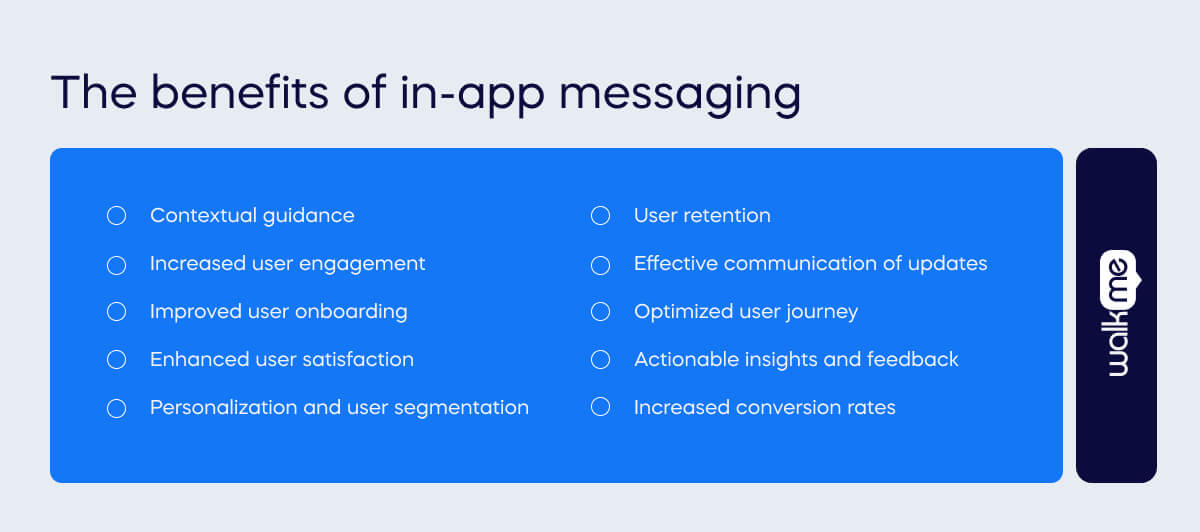
In-app messaging offers several benefits for both users and developers, contributing to an enhanced user experience and improved overall success of the application.
Here are some key advantages:
Contextual guidance
In-app messaging provides contextually relevant information at the right moment, guiding users through specific actions or processes within the application.
Users receive assistance precisely when needed, increasing the likelihood of understanding and completing tasks.
Increased user engagement
In-app messaging helps maintain user interest and engagement by delivering timely and relevant messages.
Users are more likely to stay actively involved with the application, leading to increased retention rates and a higher likelihood of continued usage.
Improved user onboarding
In-app messages are effective tools for onboarding new users, helping them understand the application’s features and functionalities.
Users receive guidance and tips during their initial interactions with the app, reducing the learning curve and enhancing the onboarding experience.
Enhanced user satisfaction
Providing users with helpful information and support within the app contributes to overall satisfaction.
Users feel supported and empowered, leading to a positive perception of the application and a higher likelihood of recommending it to others.
Personalization and user segmentation
In-app messaging allows for personalized communication based on user behavior and preferences.
Developers can tailor messages to specific user segments, delivering content more likely to resonate with individual users.
User retention
By offering just-in-time support and valuable information, in-app messaging helps retain users.
Users are likelier to continue using the app when they perceive it as a helpful and user-friendly tool.
Effective communication of updates
In-app messaging is an efficient way to communicate updates, new features, or improvements to users.
Users stay informed about changes within the app, fostering a sense of transparency and keeping them engaged with the latest offerings.
Optimized user journey
In-app messages optimize the user journey by providing guidance aligned with the user’s current activities.
Users are led through the app in a more logical and user-friendly manner, improving the overall experience.
Actionable insights and feedback
In-app messaging, including surveys or feedback prompts, enables developers to gather valuable user insights.
Developers can collect feedback on user satisfaction, identify areas for improvement, and make data-driven decisions to enhance the app.
Increased conversion rates
In-app messages can be used strategically to encourage specific actions, increasing conversion rates.
Whether promoting special offers or guiding users toward premium features, well-crafted messages can drive user actions.
What are the drawbacks of in-app messaging?
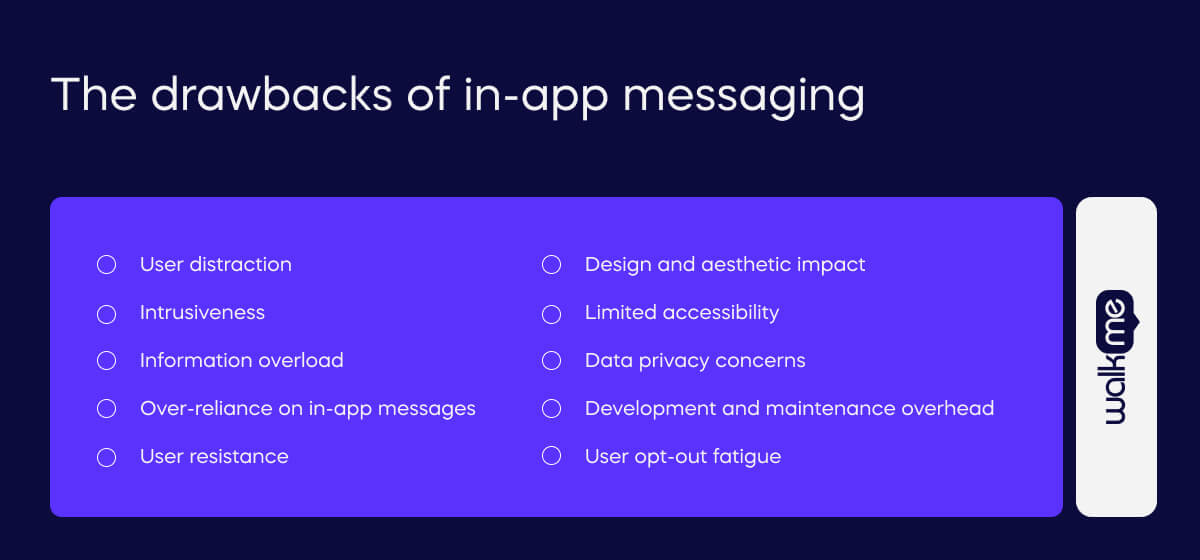
While in-app messaging can bring numerous benefits, it’s essential to consider potential drawbacks to ensure a balanced approach.
Here are some drawbacks associated with in-app messaging:
User distraction
Excessive or poorly timed in-app messages can distract users from their primary tasks.
Too many interruptions can lead to a negative user experience, especially if messages are not directly relevant or if they disrupt the flow of user interactions.
Intrusiveness
Certain types of in-app messages, such as pop-ups or modal windows, can be perceived as intrusive.
Users may find these messages disruptive, affecting their overall satisfaction and enjoyment of the application.
Information overload
Too many messages or overwhelming amounts of information can lead to information overload, followed by technostress.
Users may struggle to prioritize or absorb the information, potentially resulting in frustration or a decline in the effectiveness of the messages.
Over-reliance on in-app messages
Dependence on in-app messaging as a primary communication channel may result in users neglecting other communication channels.
It may also limit reach, as users who don’t actively use the app may miss important information.
User resistance
Some users may develop resistance to in-app messages if they perceive them as too frequent or irrelevant.
Over time, users might ignore or dismiss messages, diminishing the impact of important announcements or guidance.
Design and aesthetic impact
Poorly designed in-app messages can negatively impact the overall aesthetics of the application.
Cluttered or unappealing messages may contribute to a less visually pleasing user interface, affecting the overall user experience.
Limited accessibility
Users with disabilities may face challenges with certain types of in-app messages.
Modal windows or messages that rely heavily on visual elements may present accessibility barriers, excluding some users from accessing important information.
Data privacy concerns
In-app messages that collect personal information or track user behavior may raise privacy concerns.
Users may be hesitant to engage with messages that request sensitive information, negatively impacting trust in the application.
Development and maintenance overhead
Implementing and maintaining an effective in-app messaging system requires development resources.
Regular updates, testing, and optimization are necessary, adding to the workload of development teams.
User opt-out fatigue
Users may become fatigued by the need to repeatedly opt out of or dismiss messages.
Constantly managing opt-out preferences can frustrate users and contribute to a negative perception of the app.
In-app messaging vs. push notifications vs. email tutorials
In-app messaging, push notifications, and email tutorial sequences are different communication strategies, each with its own strengths and weaknesses.
Let’s compare these approaches:
| In-app messaging | Push notifications | Email tutorials |
| Delivered directly within the application, providing contextual and timely information during user interaction. | Appear on the device’s lock screen or notification center, ensuring immediate visibility. | Allows for more comprehensive and detailed communication, suitable for tutorial sequences. |
| Preferred by users who appreciate contextual guidance within the app. | Effective for users who want to stay informed but may not be actively using the app. | Suitable for users who prefer detailed and persistent communication. |
| No opt-in required; messages are shown within the app. | Requires user opt-in, and user preferences can impact delivery | Users must subscribe to the email list, and unsubscribing is an option. |
| Suited for concise and immediate information. | Effective for short, impactful messages. | Ideal for more detailed and educational content. |
Choosing the right communication strategy depends on your goals, the nature of the information you want to convey, and the preferences of your target audience.
Combining these strategies can create a holistic communication approach that meets various user needs.
Examples of in-app messaging in the workplace
When utilized effectively in the workplace, in-app messaging can greatly enhance communication, collaboration, and overall productivity.
Here are some examples of how in-app messaging can be rolled out in a business setting:
Employee onboarding and training
A new employee has just joined the company. In-app messages can guide them through onboarding, provide information about company policies, introduce key team members, and offer interactive tutorials on internal tools and systems.
Team collaboration
A project team is collaborating on a shared platform. In-app messaging allows team members to communicate in real-time, discuss project updates, share files, and coordinate tasks without leaving the project management application.
Announcements and company updates
The company has important announcements or updates to share. In-app messages can communicate news, policy changes, or other critical information directly to employees, ensuring that everyone is informed.
Task and project management
Team members are working on a project using a task management tool. In-app messages can notify them of upcoming deadlines, changes in project scope, or important milestones, keeping everyone on the same page.
Employee recognition
An employee has achieved a significant milestone or delivered exceptional work. In-app messaging can be used to publicly recognize and appreciate their efforts, fostering a positive and collaborative workplace culture.
Training and development opportunities
The HR department wants to promote training and development programs. In-app messages can inform employees about available courses, workshops, and learning resources, encouraging continuous professional development.
Performance feedback and reviews
It’s time for employee performance reviews. In-app messages can guide employees through the review process, provide information on performance metrics, and notify them of scheduled review meetings.
Event and meeting reminders
The company is hosting a town hall meeting or an important event. In-app messages can serve as reminders, providing details, agenda items, and any necessary preparation instructions to ensure high attendance and participation.
Employee surveys and feedback
The HR department wants to gather employee feedback on workplace satisfaction. In-app messages can include links to surveys, encouraging employees to share their thoughts on various aspects of the workplace.
Emergency communication
In case of emergencies or critical situations, in-app messaging can quickly disseminate important information, such as evacuation procedures, safety guidelines, or updates during unexpected events.
Vacation and leave requests
An employee wants to request vacation or leave. In-app messages can guide them through the process, provide information on available leave balances, and notify relevant team members and managers.
Integration with HR tools
In-app messaging can be integrated with HR tools, allowing employees to access HR-related information, submit requests, and communicate with HR representatives directly within the application.
Big businesses and in-app messaging
Several big brands have effectively implemented in-app messaging to enhance user engagement, provide support, and deliver personalized experiences.
Here are some examples of big brands that are known for using in-app messaging well:
Uber
Uber utilizes in-app messaging to inform users about promotions, provide updates on ride status, and offer personalized discounts based on user behavior and location.
Spotify
Spotify leverages in-app messaging to introduce new features, recommend personalized playlists, and notify users about exclusive content, concerts, or limited-time promotions.
Airbnb
Airbnb employs in-app messaging for communication between hosts and guests, providing real-time updates on bookings, check-in instructions, and addressing any questions or concerns users may have during their stay.
WhatsApp uses in-app messaging for user notifications, updates on new features, and to educate users on privacy settings. The platform also integrates business-related messaging for customer support.
LinkedIn incorporates in-app messaging for professional networking, allowing users to connect, communicate, and receive updates on job applications, new connections, and industry news.
Amazon
Amazon utilizes in-app messaging for order confirmations, delivery updates, and personalized product recommendations based on users’ browsing and purchase history.
Snapchat
Snapchat employs in-app messaging for real-time communication between users and for delivering personalized content, notifications about new stories, and updates on friends’ activities.
Tinder
Tinder uses in-app messaging for match notifications, introducing new features, and encouraging user engagement through personalized messages and prompts.
Waze
Waze employs in-app messaging for real-time traffic updates, safety alerts, and notifications about road closures or alternative routes based on users’ current locations.
Facebook utilizes in-app messaging for instant communication, group chats, and notifications about friend requests, event invitations, and personalized content recommendations.
Netflix
Netflix employs in-app messaging for personalized recommendations, notifications about new releases, and reminders about upcoming episodes of users’ favorite shows.
Calm
The Calm app uses in-app messaging to guide users through meditation sessions, provide updates on new mindfulness exercises, and encourage regular usage through personalized nudges.
How is an in-app messaging strategy rolled out?
Creating, assessing, and rolling out an in-app messaging strategy involves a systematic approach that considers the application’s goals, the users’ needs, and the overall user experience.
Here’s a step-by-step guide:
Define objectives and goals
Clearly define the objectives of using in-app messaging. This could include improving user engagement, reducing churn, promoting new features, or providing customer support.
Know your audience
Understand your user base and segment them based on behavior, preferences, or demographics. Tailor messages to specific user segments for maximum relevance.
Choose the right in-app messaging types
Determine the types of in-app messages that align with your goals, such as tooltips, banners, pop-ups, or interactive messages. Each type has its own strengths and use cases.
Map user journeys
Map out key user journeys within your application. Identify touchpoints where in-app messages can enhance the user experience or assist.
Determine timing and triggers
Assess the optimal timing for in-app messages. Consider triggers such as user actions, milestones, or events warranting a message.
Prioritize message content
Craft content that is concise, relevant, and aligned with user needs. Prioritize clarity and avoid overwhelming users with too much information.
Implement personalization
Utilize user data for personalization. Tailor messages based on user behavior, preferences, or past interactions to create a more personalized and engaging experience.
Test and iterate
Conduct A/B testing to evaluate the effectiveness of different message formats, content variations, or delivery timings. Use insights from testing to refine and optimize the strategy.
Monitor user feedback
Solicit user feedback on in-app messaging to understand how users perceive the messages and whether they find them helpful or intrusive.
Integrate analytics
Implement analytics tools to track the performance of in-app messages. Monitor key metrics, such as engagement rates, conversion rates, and user satisfaction.
Consider user preferences
Respect user preferences. Provide clear opt-in and opt-out options, allowing users to control the frequency and types of messages they receive.
Roll out gradually
Roll out the in-app messaging strategy gradually to specific user segments. Monitor the impact and make adjustments before implementing it more widely.
Ensure consistency
Maintain consistency in messaging style, tone, and branding across all in-app messages. This helps in reinforcing the overall brand identity.
Compliance with regulations
Ensure that your in-app messaging strategy complies with privacy regulations. Clearly communicate how user data is used and ensure data security.
Gather insights for iteration
Continuously gather insights from user feedback, analytics, and performance metrics. Use these insights to iterate on the strategy and make continuous improvements.
Provide support
Include in-app messaging for support purposes, guiding users to resources, FAQs, or customer support channels when needed.